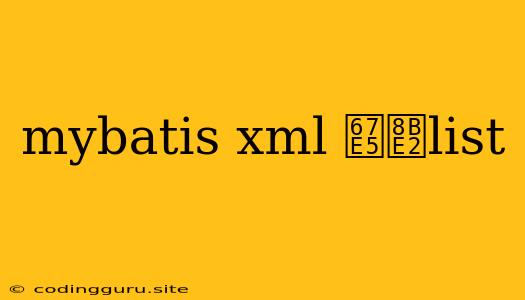Dive into the World of MyBatis XML for Powerful List Queries
MyBatis is a popular and powerful persistence framework for Java applications. It simplifies database interactions by providing an elegant way to map Java objects to relational database tables. One of the key features of MyBatis is its XML mapper files, which allow you to define SQL statements in a structured and reusable way.
But how do you effectively query and retrieve lists of objects using MyBatis XML? This is where the power of MyBatis truly shines. This article will explore the various ways to perform list queries using MyBatis XML, delving into key concepts, best practices, and examples.
Understanding the Power of MyBatis XML Mappers
MyBatis XML mappers are the heart of your database interaction strategy. They provide a flexible and declarative approach to mapping SQL statements and Java objects. Within these XML files, you can define:
- SQL Statements: Construct complex SQL queries, including JOINs, WHERE clauses, and ORDER BY statements.
- Result Mappings: Specify how the data fetched from your database should be mapped to Java objects.
- Parameters: Define the parameters that will be passed to your SQL statements.
The Essence of List Queries in MyBatis XML
When working with MyBatis, list queries are commonly employed to retrieve multiple rows of data from your database. This is often necessary when you need to present a collection of objects, like a list of products, users, or orders.
What are the common ways to execute list queries in MyBatis XML?
-
The
<select>Tag: The<select>tag is the cornerstone of retrieving data from your database using MyBatis. Within the<select>tag, you define the SQL query to retrieve the data. The key here is to specify how the retrieved results should be mapped to your Java objects.In this example, the
<select>tag defines a query that retrieves user data, mapping each row to aUserobject using theresultTypeattribute. -
The
resultMapTag: When your data structure gets more complex, especially with JOINs or nested objects,resultMapbecomes essential.resultMapprovides a powerful mechanism to map the result set to your Java objects.This example demonstrates how to map a User object, including its associated Address using
resultMap. -
Dynamic SQL: MyBatis allows you to create dynamic SQL statements based on conditions. This gives you flexibility and control over how your queries are constructed.
Here, the
whereclause dynamically adds conditions based on the presence of values in theusernameandemailparameters.
Best Practices for Effective List Queries
- Use Result Maps: Employ
resultMapwhen dealing with complex object hierarchies or JOINs. This enhances readability and reduces code complexity. - Keep SQL Statements Concise: Focus on readability and maintainability. Break down complex queries into smaller, reusable segments.
- Leverage Dynamic SQL: Make your queries flexible by using
ifandchoosetags to create dynamic conditions. - Optimize for Performance: Use indexes appropriately, avoid unnecessary joins, and keep your queries focused.
Example Scenario: Retrieving a List of Products
Let's consider a scenario where you need to retrieve a list of products with their associated categories and inventory levels.
Java Code:
List products = sqlSession.selectList("selectProducts", criteria);
// Assuming criteria contains parameters for filtering the list
MyBatis XML:
In this example, selectProducts retrieves products, categories, and inventory information based on optional criteria. The resultMap defines the mapping between the database columns and the Java objects, creating a structured Product object with nested Category and Inventory objects.
Conclusion
MyBatis XML empowers you to execute powerful list queries in a structured and maintainable way. Understanding the key concepts of <select>, resultMap, and dynamic SQL is essential for effectively working with lists of objects in your MyBatis applications. By following best practices and employing dynamic SQL for flexibility, you can create robust and scalable solutions for retrieving data from your database.
